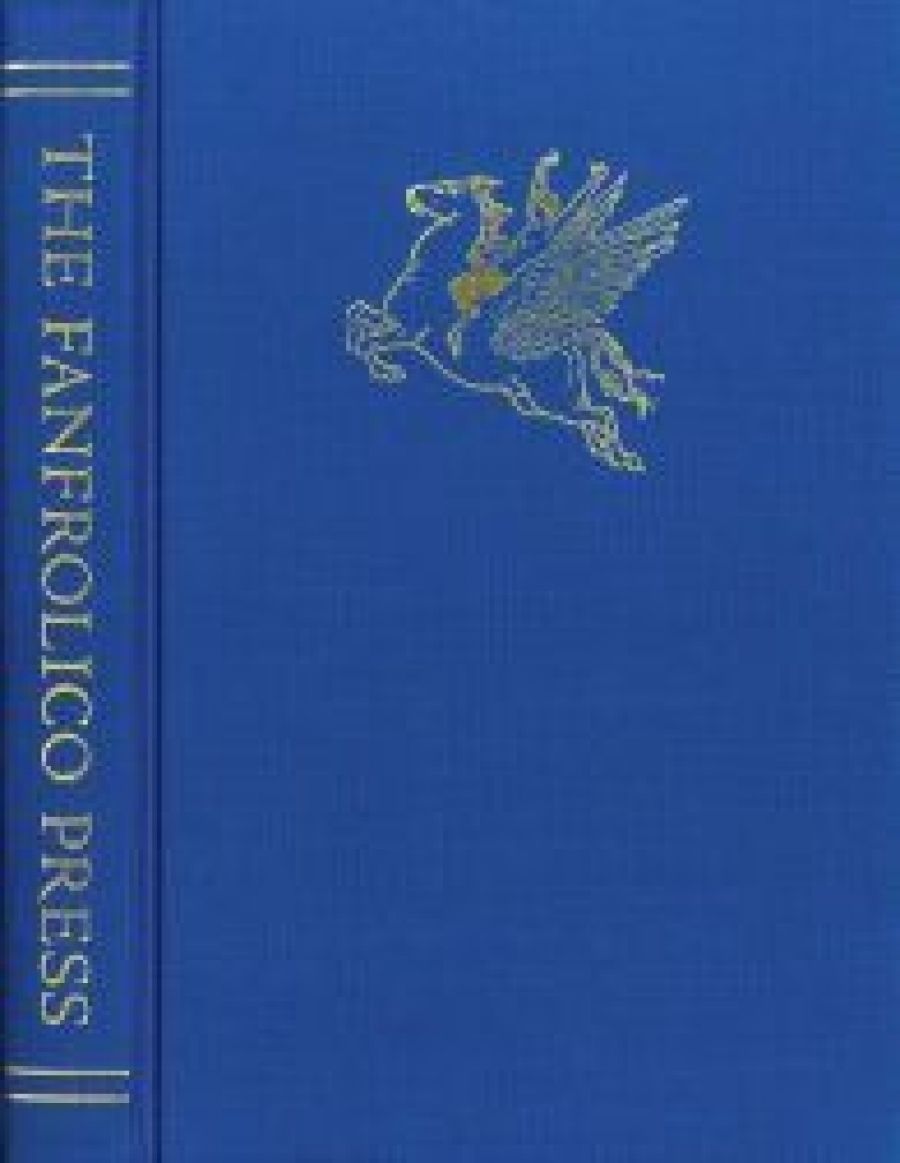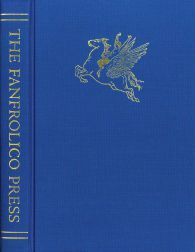
- Free Article: No
- Contents Category: History
- Review Article: Yes
- Article Title: Fanfrolico days
- Online Only: No
- Custom Highlight Text:
In what now seems to be the vanished country of the early years of my career, begun in the State Library of Victoria in the 1970s, I vividly remember John Arnold enthusing about his interest in the polymath Jack Lindsay (1900–90), son of Norman (another polymath) and one of the founders of the short-lived but gorgeously named Fanfrolico Press, whose legacy of fine books excited the keen interest of collectors. I was impressed that my precocious younger colleague had devoured Jack Lindsay’s three volumes of autobiography and had entered into an admiring correspondence with a man who in his Australian youth had found himself possessed by the written word.
- Book 1 Title: The Fanfrolico Press
- Book 1 Subtitle: Satyrs, Fauns & Fine Books
- Book 1 Biblio: Private Libraries Association, $95 hb, 328 pp
- Book 1 Cover Small (400 x 600):

By then something of a legend, with achievements over an extraordinary range – poetry, translation, publishing, fiction, history, cultural anthropology, verse drama and biography – Lindsay was living at Castle Hedingham in Essex, far removed from the country of his birth, which he had farewelled, streamers in hand, from the decks of the Maloja when it sailed from Sydney in February 1926. But if Lindsay had opted early for the expatriate life, he was later to be honoured at home. In 1984 his many achievements and his remarkable diversity of interests were brought into close focus in Culture & History, a volume of celebratory essays, edited by Bernard Smith and published in Sydney by Hale & Iremonger. John Arnold was one of the contributors to this tribute, both as the author of a piece on Lindsay’s Australian youth and as the compiler of a meticulous bibliography and checklist of his books in their various forms. That listing is an imposing aggregation running to some thirty closely printed pages.
It is in those two pieces of scholarship as well as in his youthful reading of Lindsay’s autobiography that we may trace the foundations of Arnold’s most recent work, this magisterial history of the Fanfrolico Press, elegantly designed by Paul W. Nash and published by the Private Libraries Association in England. In acknowledging the source of his interest in Lindsay, Arnold declares a special debt to Fanfrolico and After (1962), the moving third volume of Lindsay’s autobiography. He mentions briefly that it was this book that stimulated his interest in the work of Lindsay and inspired him to write a history of the Fanfrolico Press.
‘Inspired’ is exactly the right word, for there is no doubt that Arnold has produced a lovingly crafted account of the Fanfrolico enterprise, that short and far from easy chapter in Lindsay’s long and richly productive life. While almost from the outset Fanfrolico struggled financially, and while creative and personal tensions emerged between its Australian partners – first with co-founder John Kirtley and later with the buccaneering P.R. Stephensen, whose arrival pushed Kirtley aside – the venture nevertheless produced a yield of forty-six handsome books, including the first, Jack Lindsay’s own Fauns and Ladies (1923); Kenneth Slessor’s Thief of the Moon (1924) and Earth-Visitors (1926); A Homage to Sappho (1928), a translation of Sappho’s love poems by Norman and Jack Lindsay; and Hugh McCrae’s Satyrs and Sunlight (1928).
Not all the Fanfrolico books, even those listed here, are equal in quality or interest, but the enterprise, run with Australian bravura and considerable ambition, made its mark briefly in the rarefied world of the private press movement that flourished in England in the 1920s. In a Retrospect, Arnold concurs with the judgement of Roderick Cave, the historian of the private presses, that the 1920s would have been the poorer without Fanfrolico’s attempts ‘to storm the battlements of the English literary establishment with a new critique’.
There can be no doubt that Arnold is an author in absolute command of his subject. Over more than thirty-five years of the writer’s busy and demanding career in libraries, bookselling and academia, his book has had a slow gestation, but the wait has been worthwhile. Arnold offers a detailed history and full bibliography of the Fanfrolico Press (this edited by Paul W. Nash), tracing the venture from its beginnings in Sydney in 1923, through its heyday in London, to its eventual bankruptcy and dissolution in the Depression year of 1930. While Arnold understands the larger contours of Lindsay’s life, both its sometimes frustrated youthful ambition and its later florescence, he is deft and restrained in constructing the disciplined miniature that is the particular story of the Fanfrolico enterprise that rode opportunistically in the beginning on the back of Norman Lindsay’s name and his prolific drawings, but that was later driven by the creative vision of its embattled collaborators.
The Fanfrolico story is both highly particular and entirely self-contained. Its principals went on to other careers: Lindsay as a dauntingly prolific writer, a twentieth-century ‘renaissance man’; Stephensen as something of a maverick, ‘a wild man of letters’ who later became a commercial publisher in Australia; only poor John Kirtley was eventually lost to the world of books, but not before he had produced at his Mountainside Press, Ferntree Gully Lower, R.D. Fitzgerald’s Heemskerck Shoals (1949), one of the finest books ever produced in Australia. Those other stories have been told elsewhere or still await proper appraisal.
Emphatically, John Arnold has made in his Fanfrolico narrative a singular contribution to Australia’s book history (building on much other work he has done across this major field of interest). As his text reveals, together with his richly detailed notes, his scholarship is as wide-ranging as it is meticulous. In its specialist field, this is a landmark study by an author with a commanding knowledge of his subject but also with a sensitivity to its human story. Dedicated to the memory of his own father, there is in the honour done to Jack Lindsay a moving personal note of filial respect and celebration. In the book itself – the spacious layout of the pages, its fine paper and typography, the quality of its illustrations, including reduced facsimiles of each Fanfrolico title – the highest tribute is paid to the work of the Press it so abundantly records and defines.


Comments powered by CComment